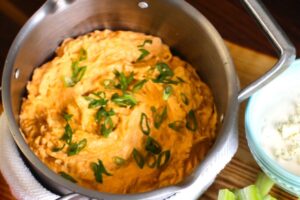What is Natural Flavor in Food Products?
Natural Flavor on a Food Label
Have you ever picked up a food product at the grocery store, glanced at the ingredient list, and come across the enigmatic term “natural flavor”? If you’ve ever wondered what exactly this means and whether it’s something to be concerned about, you’re not alone. “Natural flavor” is a common yet often misunderstood ingredient found in a wide variety of food products. In this blog post, we’ll explore the world of natural flavors, what they are, how they’re made, and whether they’re safe to consume.
What is Natural Flavor?
How are Natural Flavors Made?
Are Natural Flavors Safe?
FDA Code of Regulations for Natural Flavor on a Label
Allergens and Natural Flavors
MSG and Natural Flavors
What is Listed in Cook’s Delight Natural Flavor?
Cook’s Delight® Bases and Health Trends
What is Natural Flavor?
“Natural flavor” is a term used in food labeling to describe flavoring substances that are derived from natural sources, such as fruits, vegetables, herbs, spices, and even some animal products. These substances are typically used to enhance the taste of food products and are responsible for providing the characteristic flavor and aroma associated with certain foods.
It’s important to note that “natural flavor” can encompass a wide range of ingredients, and not all natural flavors are the same. They can be derived from single sources or a combination of various natural sources to create a specific flavor profile.
For example, vegetable powders are made by drying then crushing into flakes or powders. The natural flavor of strawberry ice cream may be created using a blend of strawberry extracts and other natural ingredients to achieve the desired taste.
How Are Natural Flavors Made?
The process of creating natural flavors involves extracting and isolating the volatile compounds responsible for a specific taste or aroma from natural sources. Here’s a simplified overview of the steps involved:
- Source Selection: Manufacturers start by selecting the natural source(s) that will provide the desired flavor. This can include fruits, vegetables, herbs, spices, and more.
- Powders: Making powders, such as onion powder, carrot powder or garlic powder, is a fairly straightforward process. The ingredient is first dried (air, dehydrated or freeze-dried) and then crushed into flakes, granuals or a fine powder.
- Extraction: The flavor compounds are extracted from the chosen source(s) using various methods, such as distillation, pressing, or solvent extraction.
- Isolation: Once extracted, the volatile compounds are isolated to obtain the pure flavor essence.
- Blending: In some cases, multiple isolated compounds or extracts are combined to create a complex, well-rounded flavor profile.
- Formulation: The final natural flavor is formulated into a food product in carefully measured quantities to achieve the desired taste.
Are Natural Flavors Safe?
The safety of natural flavors is a topic of concern for many consumers. It’s important to understand that natural flavors must adhere to strict regulations and safety standards set by government agencies, such as the Food and Drug Administration (FDA) in the United States. These regulations ensure that natural flavors used in food products are safe for consumption and do not pose health risks when used as intended.
Natural flavors are generally considered safe for the following reasons:
- Regulatory Oversight: Food regulatory agencies rigorously evaluate and approve natural flavor ingredients for safety before they can be used in food products.
- Testing and Evaluation: Extensive testing is conducted to assess the safety of natural flavor ingredients, including toxicity studies and evaluations of potential allergenicity.
- Natural Sources: Natural flavors are derived from natural sources, making them inherently safer than some artificial flavorings.
- Limited Usage: Natural flavors are typically used in small quantities to achieve the desired taste, minimizing any potential health risks.
FDA Code of Regulations for Natural Flavor on a Label
Any ingredient that is listed in natural flavoring complies with the Code of Federal Regulations 21 CFR Part 101.22.
21 CFR Part 101.22
§ 101.22 Foods; labeling of spices, flavorings, colorings and chemical preservatives.
(3) The term natural flavor or natural flavoring means the essential oil, oleoresin, essence or extractive, protein hydrolysate, distillate, or any product of roasting, heating or enzymolysis, which contains the flavoring constituents derived from a spice, fruit or fruit juice, vegetable or vegetable juice, edible yeast, herb, bark, bud, root, leaf or similar plant material, meat, seafood, poultry, eggs, dairy products, or fermentation products thereof, whose significant function in food is flavoring rather than nutritional. Natural flavors include the natural essence or extractives obtained from plants listed in §§ 182.10, 182.20, 182.40, and 182.50 and part 184 of this chapter, and the substances listed in § 172.510 of this chapter.
Allergens and Natural Flavors
Allergen Disclosure
In most countries, including the United States, food manufacturers are required by law to disclose the presence of the Big 9 common allergens like milk, eggs, soy, peanuts, tree nuts, fish, shellfish, sesame and wheat in their ingredient statements. These allergens are not permitted to be hidden within natural flavors or any other ingredient. If any of these allergens are present in natural flavors, they must be explicitly listed in the ingredient statement.
MSG and Natural Flavors
Now, let’s explore whether MSG can be hidden under the cloak of “natural flavors”:
The MSG Controversy
MSG is a flavor enhancer commonly used in many processed foods to enhance their savory or umami taste. It has been a topic of debate, with some individuals reporting sensitivity or adverse reactions to it.
Labeling of MSG
In the United States, the FDA requires food manufacturers to list MSG explicitly on food labels if it’s added as a separate ingredient. However, there is a common misconception that MSG can be hidden under the label “natural flavors.” This is not the case. If MSG is used as an ingredient, it must be disclosed on the label, just like any other ingredient.
What is Listed in Cook’s Delight® Natural Flavor?
When creating ingredient statements for products developed under the Cook’s Delight® label, Integrative Flavors® complies with the Code of Federal Regulations 21 CFR Part 101.22.
The Big 9 Allergens and Monosodium Glutamate are NEVER “hidden” in Natural Flavors.
The Big 9 Allergens and Monosodium Glutamate are listed as ingredients on the ingredient statement, if they are ingredients in a Cook’s Delight® soup base.
Cook’s Delight® Bases and Health Trends
Discover the versatile magic of soup bases and flavor concentrates by Cook’s Delight®! Whether you’re managing a bustling foodservice operation, or crafting industrial-scale culinary formulas or cooking up a storm in your home kitchen, our soup bases are your secret weapon for achieving consistently delectable flavors.
Say goodbye to the uncertainties of quality management and the hassles of labor-intensive preparation. Our soup bases and flavor concentrates take the guesswork out of your recipes, ensuring a reliable and predictable flavor profile every time. No more worrying about inconsistent results; you can trust Cook’s Delight® to deliver.
Convenience is key, and we’ve got you covered there too. Our products are available in convenient pack sizes, making it easy to source the exact amount you need without concerns of shortage or storage. With our shelf-stable options, you can stock up worry-free.
In an ever-evolving world of health trends, Cook’s Delight® keeps pace with our new line of Zero Sugar Bases. Designed with professional chefs in mind, these bases provide a solution for those looking to take control of the sugar content in their culinary creations. Available in chicken, beef, and vegetable varieties (both organic and conventional), our Zero Sugar Bases are gluten-free and boast a clean label. They contain no MSG, no Big 9 allergens, and no trans fats.
These products align with the guidelines of various popular zero sugar diets, making them suitable for those following KETO, vegan, and low-carb lifestyles. At Cook’s Delight®, we understand that dietary preferences and needs vary, and we’re committed to providing options that cater to all. Upgrade your culinary game with our Zero Sugar Bases and elevate your dishes to new heights while maintaining a commitment to health-conscious cooking.
Explore Cook’s Delight® bases that meet your needs by using our tool to customize your search. Simply check the box(es) of the requirements you are looking for in a base and view the bases that meet your criteria.
Submit a request for your sample. These bases are a perfect addition to your distribution product line.
Where Can I Purchase Cook’s Delight® Base?
Cook’s Delight® has several base options for foodservice and industrial users
Stock item chicken bases are also available with low minimum orders
Recipe ideas using soup base:
 |
 |
 |
| Mashed Potatoes Recipe | Buffalo Chicken Dip Recipe | Egg Drop Soup Recipe |
